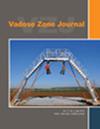法国西南部莫拉西丘陵地区种植的粘性钙化土的主要水通道:土壤内涝的空间化
IF 2.8
3区 地球科学
Q3 ENVIRONMENTAL SCIENCES
引用次数: 0
摘要
法国西南部粘性-钙质土壤的陡坡上经常发生局部内涝,导致营养物质和污染物转移到水体,减少生态系统服务。这些土壤发育于中新世莫拉西丘陵地层,通常不透水,具有丰富的水成形体痕迹和不均匀的空间分布。本文旨在通过对土壤、水文和地球物理特征的交叉分析,描述这些土壤的水文功能。我们的实验地点位于Auradé(法国西南部)的集水区。在这里,我们分析了2020年9月至2021年9月研究流域出口的流量以及测压和气候监测。我们发现,水文年分为三个阶段:第一,有效降雨量约为100毫米的土壤补给阶段;第二,饱和阶段,80%的有效降水主要通过径流和皮下流排出;第三,干燥阶段。土壤内涝事件通常发生在饱和阶段。它们是由几种形式的流动引起的:与回流相关的地表径流,由地下水力传导率较低的土层(膨胀粘土和犁底)引起的地下水流,以及山坡土壤地下水位与冲积地下水位间歇性连接的地下水流。我们还进行了独立的地震折射层析成像分析,验证了集水区的局部内涝模式,并为在研究地块的规模上对高内涝潜力区域进行空间化开辟了道路。本文章由计算机程序翻译,如有差异,请以英文原文为准。
Main water pathways in cultivated clayey calcisols in molassic hills in southwestern France: Toward spatialization of soil waterlogging
Local waterlogging often occurs on the steep slopes of clayey–calcareous soils in southwestern France, causing nutrients and pollutants transfer to the river bodies and reduced ecosystems services. These soils developed in the Miocene molassic hill formation and are generally impermeable with abundant traces of hydromorphy and heterogenous spatial distribution. This article aims to describe the hydrological functioning of these soils, based on a cross analysis of pedological, hydrological, and geophysical characterizations. Our experimental site is the catchment area located in Auradé (southwestern France). Here, we analyze the flows at the outlet of the studied watershed together with piezometric and climatic monitoring from September 2020 to September 2021. We show that the hydrological year is divided into three phases: first, a soil recharge phase with an effective rainfall of about 100 mm; second, a saturation phase, when 80% of the effective precipitation is drained mostly by runoff and hypodermic flows; third, a drying phase. Soil waterlogging events usually occur during the saturation phase. They are due to several forms of flow: surface runoff associated with return flow, hypodermic flow caused by the presence of soil layers with lower hydraulic conductivity in the subsurface (swelling clays and plowing sole) and groundwater flow with intermittent connection of the soil water table in the hillside to the alluvial groundwater table. We also conducted independent seismic refraction tomography analyses that validate localized waterlogging patterns along the catchment and open the way to spatializing areas with high waterlogging potential at the scale of the study plot.
求助全文
通过发布文献求助,成功后即可免费获取论文全文。
去求助
来源期刊

Vadose Zone Journal
环境科学-环境科学
CiteScore
5.60
自引率
7.10%
发文量
61
审稿时长
3.8 months
期刊介绍:
Vadose Zone Journal is a unique publication outlet for interdisciplinary research and assessment of the vadose zone, the portion of the Critical Zone that comprises the Earth’s critical living surface down to groundwater. It is a peer-reviewed, international journal publishing reviews, original research, and special sections across a wide range of disciplines. Vadose Zone Journal reports fundamental and applied research from disciplinary and multidisciplinary investigations, including assessment and policy analyses, of the mostly unsaturated zone between the soil surface and the groundwater table. The goal is to disseminate information to facilitate science-based decision-making and sustainable management of the vadose zone. Examples of topic areas suitable for VZJ are variably saturated fluid flow, heat and solute transport in granular and fractured media, flow processes in the capillary fringe at or near the water table, water table management, regional and global climate change impacts on the vadose zone, carbon sequestration, design and performance of waste disposal facilities, long-term stewardship of contaminated sites in the vadose zone, biogeochemical transformation processes, microbial processes in shallow and deep formations, bioremediation, and the fate and transport of radionuclides, inorganic and organic chemicals, colloids, viruses, and microorganisms. Articles in VZJ also address yet-to-be-resolved issues, such as how to quantify heterogeneity of subsurface processes and properties, and how to couple physical, chemical, and biological processes across a range of spatial scales from the molecular to the global.
 求助内容:
求助内容: 应助结果提醒方式:
应助结果提醒方式:


